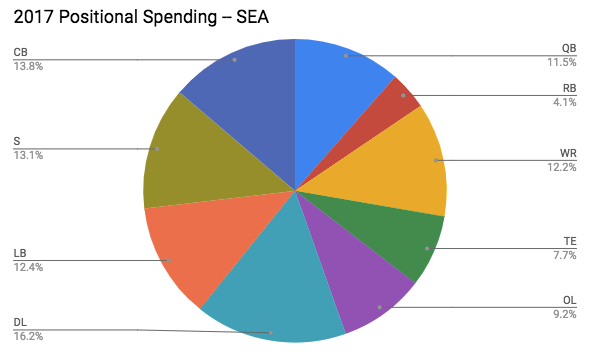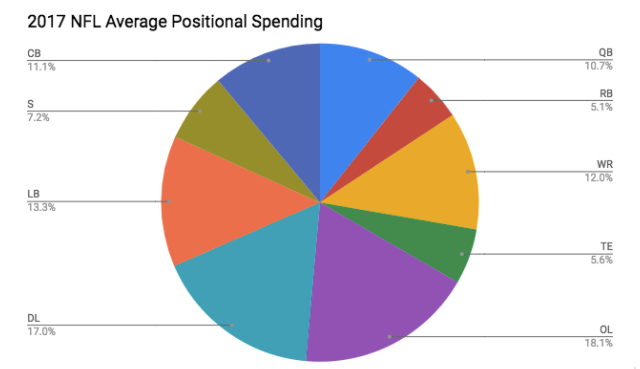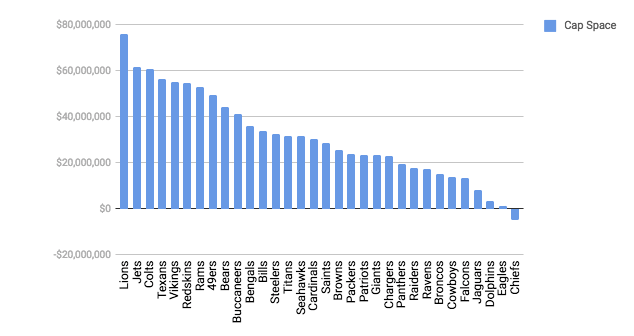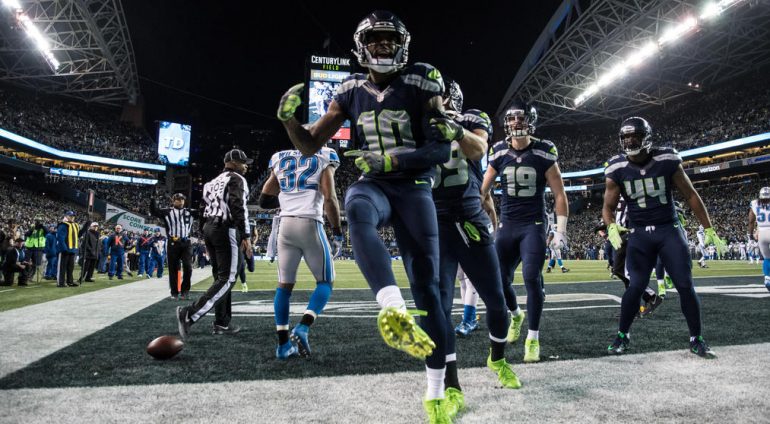Football is back.
After an offseason full of peculiar and surprising moves, the Russell Wilson led Seattle Seahawks are looking to make yet another run at the big one. As we inch closer to the start of the 2017 season, Seattle has carefully positioned themselves to offer extensions to some of their most dynamic players. When discussing NFL contracts and the salary cap, many fans tune out — whether it’s due to too many numbers, too many competing NFL regulations, or too many big words.
My hope is that I can break down the Seahawks cap philosophies in simple terms: in words that the average fan with minimal salary cap knowledge can understand. Without further ado, let’s dive in.
Let’s start with the basics
As it stands right now, the Seahawks have about $8M in cap space entering the season. If you’d like to include all those miscellaneous expenditures like Injured Reserve (~$2M), Practice Squad (~$1M), and any future dead money (~$1M) — you’re looking at a more accurate number of about $4M in true cap space. When I say “true” cap space, I’m simply accounting for those miscellaneous expenditures that every NFL team needs to budget for. It’s safe to say that anyone who quotes the Seahawks to have about $4-8M in cap space, give or take a little, is painting an accurate picture.
Here’s a positional spending breakdown for Seattle’s 2017 roster (numbers per OTC):

And here’s what the average positional spending looks like across all teams (in 2017):

Notice how Seattle spends considerably less on the OL than the average NFL team. This allows them to spend considerably more on extensions for their top defensive players. Looking forward, Over the Cap has the Seahawks positioned to have $31.5M in 2018 cap space.

However, that doesn’t include extensions for some of the Seattle’s more notable players — and it maintains all current contracts on the books. I recently spoke with Jason Fitzgerald from Over the Cap, who had some thoughts on Seattle’s cap flexibility moving forward:
“It’s relatively healthy at the moment. They are about average in projected cap room for 2018 and in the top third for projected cap space in 2019. Of course they will also have free agent decisions to make with their own players but I don’t believe that the salary cap will be the reason they do or do not re-sign anyone.”
Thoughts on free agency moves
Seattle had quite the busy offseason, especially in free agency. RT Garry Gilliam left for the 49ers after the Seahawks declined to match San Francisco’s offer sheet. This was a move that divided fans. After a shaky start to the 2016 season, Gilliam gained steam but was inexplicably benched. Rumors indicated that his benching wasn’t a result of on-field play. Either way, the Seahawks are hoping that Germain Ifedi will take over and hold down the right tackle spot. However, Seattle didn’t just lose an offensive lineman. They also added Oday Aboushi, RG from the Texans. Aboushi is supposedly an adequate fill-in when needed, who happens to be a better pass defender than run blocker. With a cap hit of $975K, there’s not much to lose here. We’ll see what he can do.
They also added LG/LT Luke Joeckel to the mix, from the Jaguars. However, they paid him a $7M salary on a one year deal, which shocked many fans. That’s a high salary for a player with serious injury concerns and questionable play. Jason had some thoughts on this deal:
“I know that the contract is only for one year, but that Luke Joeckel contract has to be one of the worst, if not the worst, signed this year, maybe even the last few years. There is really no justification for the salary whatsoever. Even if you are really bullish on the player, and clearly Seattle was, if the other 31 teams think are lukewarm at best there is no need to go as high as they did.”
I’m very pessimistic about this deal — but I’m going to let it play out. However, it’s not all doom and gloom. Seattle added safety Bradley McDougald from the Bucs. Jason had positive thoughts on this deal:
“The Bradley McDougald contract is a total steal. That was a spot where they waited out a surprising free agent fall and got a great contract for a guy that has potential to earn a few million more with a good year.”
If Kam misses any amount of time due to injury, McDougald and Delano Hill will likely compete for his role. I assume Seattle would also like to use McDougald in some special defensive packages. His 2017 expectations are an unknown, but he might be a player we look back on as one of Seattle’s defining offseason moves.Seattle also added Eddie Lacy, who fizzled out in Green Bay. This move screams of an attempt to conform back to their old “punch em in the mouth” running style. Thomas Rawls and CJ Prosise both maintain injury concerns, so adding another back to the mix wasn’t the worst idea. We’ll call this committee the three headed dragon — one of them has to pan out, right? With most of these players on one year deals, Seattle’s new free agent signings will be motivated in fighting for extensions.
Potential extensions
Seattle has some big decisions to make. Notable players eligible for extension (or soon to be eligible) include Justin Britt, Deshawn Shead, Kam Chancellor, Frank Clark, Paul Richardson, and Jimmy Graham. Jason provided some insight insight on Seattle’s extension candidates:
“I know it is risky but I think I’d look at extending Paul Richardson and keep my fingers crossed that his showing in the playoffs is an indication that he is finally going to get it. They kind of shot themselves in the foot with the Kearse contract which is probably what Richardson would want, but if the guy can legit develop into a number 2 and you can lock him up for $3-4.5 million it’s a great bargain.”
I was surprised by Jason’s thoughts on Prich. He’s a player that I feel has very limited abilities as a receiver. He holds obvious injury concerns and lacks comprehensive route running skills. This is really one of those situations where the player could either boom or bust following an extension. If he explodes, you’d have him on a great number. But I’m not sure that will happen. I would take a calculated risk and let Richardson walk. I’m confident in Baldwin, Lockett, and Amara Darboh steering the ship. Jason had more to say:
“Justin Britt is the most logical extension. The only negative is that he has a low cap charge so they won’t get much in the way of savings by extending him, so if they were also going to extend Richardson it might be tough on the cap to do both. Britt is the better player but generally there is a much more lukewarm market for centers than wide receivers in free agency.”
Britt is my #1 target for an extension. I believe a quarterback’s relationship with the center is critical towards developing a consistent offense. The communication that occurs between the center and quarterback is vital, as the center plays pivotal roles in determining coverage schemes and assignments. I’d like Britt to develop that long term center-quarterback relationship with none other than #3. He was far and away the best offensive lineman for Seattle in 2016, and his presence in the locker room is valued. If he asks for $8M APY, they should pay it. If he asks for $9M APY, they should pay it. And if he asks for $10M APY, they should pay it.
Brandon Linder, center for the Jaguars, just recently received a massive extension making him the highest paid center in NFL history. This deal will be a key comparison for Britt’s agent. The five year deal has a total value of $51.7M, with $24M in guaranteed money. The deal has an APY (average per year) of $10.34M. I am absolutely firm in my belief that if you value Russell Wilson as your franchise quarterback, you need to start wisely investing salary cap dollars to protect him. Tom Cable’s recent praise of the center reaffirms his impact in the locker room:
OL coach Tom Cable just said C Justin Britt has become a leader like Max Unger. That's the highest praise Cable has. #Seahawks
— Gregg Bell (@gbellseattle) June 9, 2017
Extension Prediction: 4 years/$37M with $16M guaranteed.
Jason continued:
“The big names are Kam Chancellor and Jimmy Graham. I don’t think I would extend Graham. He’s still a pretty good tight end, but he’ll make the turn past 30 this year and I think will be too expensive for what I believe his production will be moving forward. Extending Chancellor probably saves the team from a lot of headaches this summer but it depends on what he is looking for. Some of the numbers that have been rumored are astronomical for his position and I don’t see that as being a long term smart move. There are a few guys later in the year like Earl Thomas who I could see getting a new deal, but I don’t think that happens in the summer.”
The potential of a new deal for Jimmy Graham has many Seahawks fans divided. I don’t think anyone would argue that Graham doesn’t have HOF talent, and that he isn’t one of the best tight ends in the NFL. However, he commands a high salary. A $9-10M salary would retain Justin Britt, or two mid-tier players. An additional factor to consider is his replacement value. Nick Vannett hasn’t shown anything and Luke Willson is on a one year deal. They didn’t draft any in a loaded tight end class either. At the end of the day, I ask myself this question with every player: “Does his role and production justify his salary?”. For Graham, I’m not sure it does. If they extend him at a decent number (~$9-10M APY), great. If they don’t, I’m not going to fret over it.
Kam Chancellor, a veteran and founding member of the Legion of Boom, has an even more interesting case. At age 29, his body has started to break down. He hasn’t played 16 games since the 2013 season and he’s missed a total of nine games in his last two seasons. His hard hitting style of play has caught up with him, and extending him to a large contract comes with a high risk. On the other hand, his presence in the locker room appears essential. This one hurts to say — but I think Seattle should let Kam walk. Seattle drafted multiple defensive backs in the 2017 draft, with high hopes especially for strong safety Delano Hill. If you offer him an extension, don’t expect him to play more than 12 games a year. Offering a top tier contract to a safety just before the age of 30 is begging for trouble. It hurts to say, because I love the player and the person, but the Seahawks should let Chancellor walk if they value their future cap flexibility. The money can be more wisely spent elsewhere — and I’m willing to bet on Delano moving forward.
In regards to Shead, he was having a breakout 2016 season until his ACL injury. If he can sufficiently recover from that injury and reassume his 2016 form (or come close to it), I’d prefer they keep him. However, it really, really depends on his recovery. If he has a successful 2017 season, he could command a large number at the end – the corner market was and is still hot.
Fans aren’t talking about it now, but Seattle should look to extend Frank Clark following the 2017 season. He’s mostly stayed out of trouble during his stint in Seattle — and if he can maintain good behavior off the field, he will be one of the NFL’s elite young pass rushers (if he isn’t already). I could see Clark getting extended at $60M over four years (~$15-17M APY). The market for pass rushers is insane, and Frank will be a young, elite defender entering his prime. Lock him up early, Seattle.
Potential cuts
I don’t envision any notable players getting axed during the 2017 season, but there are some whose 2017 performance will immediately determine their future. Players in danger of losing their jobs include Jermaine Kearse, Jeremy Lane, and Ahtyba Rubin. Look for Amara Darboh, who was drafted in the third round of the 2017 draft, to fight Kearse for that #3 wide receiver spot behind Lockett. Lane has fresh competition in newly drafted corner Shaquille Thompson. And Rubin could get buried among the reinforcements to the defensive line.
If the Seahawks cut Lane in 2018, that $31.5M cap space number jumps up to $36.2M (saving Seattle $4.75M). If they cut Kearse, that $31.5M cap number bumps up to $36.5M (saving Seattle $5M). And finally, if they cut Rubin, that $31.5M cap number rises to $35.3M (saving Seattle $3.8M). Cutting all three of them would raise their cap space from $31.5M to just over $45M.
If you follow me on Twitter, you’ll know that I completely despise Kearse’s contract. He’ll have to have a major bounceback season to come anywhere close to justifying his salary moving forward.
Moving forward
With $30M+ in cap space in 2018, I think Seattle has positioned themselves in a good spot. They have the cap space and the flexibility to offer some big extensions to some of their key players, but they must spend wisely. Extending Kam to a top tier deal would be a mistake. With high expectations for Delano Hill, Seattle should look to move on to the next generation of the Legion of Boom. The case of Jimmy Graham is also a divisive one, and Seattle might be waiting to see how he performs in 2017 to offer him an extension.
The Seahawks must start wisely investing salary cap dollars in the offensive line. After an injury riddled season to their most critical player, internal philosophies may be slightly shifting. Seattle showed signs of this with a strong offer to TJ Lang, and throwing a ton of money at Luke Joeckel. A Britt extension would be a another step in the right direction. Jason had this to say:
“They are facing extensions with a number of players who are at that borderline age where you really have to weigh the benefits of the immediate benefit versus potential wasted space one or two years later. On the five or six year contracts those decisions are easier. I think we saw that dilemma this offseason with Sherman who is basically nearing that age where players like Revis and Asomugha fell, but shouldn’t hit that age until his free agent year or the year after. It presents a different set of decisions for this team than some of the other successful teams face with their core players.”
Without a doubt, big decisions loom.
